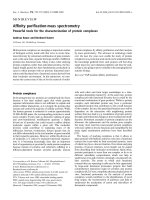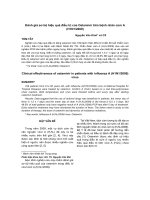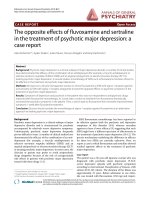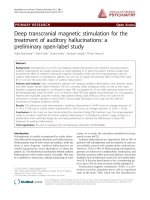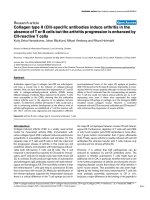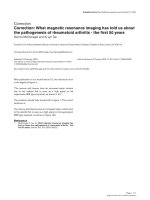Báo cáo y học: " Pregnancy and delivery while receiving vagus nerve stimulation for the treatment of major depression: a case report" pot
Bạn đang xem bản rút gọn của tài liệu. Xem và tải ngay bản đầy đủ của tài liệu tại đây (279.02 KB, 7 trang )
BioMed Central
Page 1 of 7
(page number not for citation purposes)
Annals of General Psychiatry
Open Access
Case report
Pregnancy and delivery while receiving vagus nerve stimulation for
the treatment of major depression: a case report
Mustafa M Husain*, Diane Stegman and Kenneth Trevino
Address: University of Texas Southwestern Medical Center at Dallas, 5323 Harry Hines Blvd, Dallas, Texas 75390-8898, USA
Email: Mustafa M Husain* - ; Diane Stegman - ;
Kenneth Trevino -
* Corresponding author
Abstract
Background: Depression during pregnancy can have significant health consequences for the
mother and her infant. Antidepressant medications, which pass through the placenta, may increase
the risk of low birth weight and preterm delivery. The use of selective serotonin reuptake inhibitors
(SSRIs) during pregnancy may induce serotonergic symptoms in the infant after delivery.
Antidepressant medications in breast milk may also be passed to an infant. Vagus nerve stimulation
(VNS) therapy is an effective non-pharmacologic treatment for treatment-resistant depression
(TRD), but little information exists regarding the use of VNS therapy during pregnancy.
Case presentation: The patient began receiving VNS therapy for TRD in March 1999. The
therapy was effective, producing substantial reductions in depressive symptoms and improvement
of function. In 2002, the patient reported that she was pregnant. She continued receiving VNS
therapy throughout her pregnancy, labor, and delivery, which enabled the sustained remission of
her depression. The pregnancy was uneventful; a healthy daughter was delivered at full term.
Conclusion: In this case, VNS therapy provided effective treatment for TRD during pregnancy and
delivery. VNS was safe for the patient and her child.
Background
A pregnant patient with major depression requires effec-
tive management of depressive symptoms for her own
health and that of her child. Estimates of the prevalence of
depression among pregnant women vary widely, ranging
from 3.3% for major depression [1] to 20% for any type
of depression [2]. Rates of depression may be as high as
51% in selected populations [3]. These rates compare with
a 12-month worldwide prevalence of depression of 9.5%
in women [4]. Among pregnant women with depression,
many are untreated, sometimes discontinuing treatment
for depression after becoming pregnant [1,5].
Depression during pregnancy can have many serious con-
sequences. For the mother, depression is associated with
an overall decline in general health, physical and social
functioning, an increase in the experience of pain [3], and
obstetric complications [6-8]. Depression in late preg-
nancy is associated with post-partum depression [2],
while depression in early pregnancy increases the risk of
preeclampsia, a major complication characterized by rap-
idly progressive hypertension with proteinuria, edema, or
both [9]. For the infant, maternal depression during preg-
nancy was associated with admission to a neonatal inten-
sive care unit [7] and with spontaneous preterm delivery
in one study [10] but not in another [11].
Published: 16 September 2005
Annals of General Psychiatry 2005, 4:16 doi:10.1186/1744-859X-4-16
Received: 25 July 2005
Accepted: 16 September 2005
This article is available from: />© 2005 Husain et al; licensee BioMed Central Ltd.
This is an Open Access article distributed under the terms of the Creative Commons Attribution License ( />),
which permits unrestricted use, distribution, and reproduction in any medium, provided the original work is properly cited.
Annals of General Psychiatry 2005, 4:16 />Page 2 of 7
(page number not for citation purposes)
Because of the importance of managing depression during
pregnancy, numerous studies have examined the effects of
antidepressant medications on fetal and infant develop-
ment. Antidepressants and their metabolites pass through
the placenta [12] and increase the risk of low birth weight
[13,14] and preterm delivery [14,15]. Use of selective
serotonin reuptake inhibitors (SSRIs) by mothers during
pregnancy has been associated with substantially reduced
levels of platelet serotonin in newborns [16], which may
account for SSRI-induced serotonergic symptoms [17],
serotonin withdrawal syndrome[18], tremulousness,
reduced motor activity, heart rate variability [15], and
blunted pain response [19,20]. Increased dosing of SSRIs
may be required to maintain euthymia during later stages
of pregnancy [21], which may exacerbate some effects.
Antidepressants are transmitted to infants in breast milk,
where they usually have no discernible clinical effect.
However, in isolated reports, antidepressants in breast
milk have been associated with reduced feeding, somno-
lence, reduced growth, and possible seizure [22]. Because
both depression and its treatment with pharmacologic
interventions may pose risks to the patient and her child,
it is important to identify safe nonpharmacologic thera-
pies for that may be used to treat major depressive epi-
sodes during pregnancy.
Vagus nerve stimulation (VNS) therapy has been evalu-
ated for use in TRD [23-25]. A small pulse generator
implanted subcutaneously in the left thoracic area delivers
mild programmed pulses through an implanted lead to
the left vagus nerve in the neck. Approved for the treat-
ment of epilepsy since 1997, VNS therapy has been
administered to more than 32,000 patients worldwide
[26]. Several clinical studies have evaluated the use of
adjunctive VNS therapy in chronic or recurrent TRD.
In a 3-month open-label pilot study of patients with
chronic or recurrent TRD (bipolar or unipolar, defined by
Diagnostic and Statistical Manual of Mental Disorders,
4th Edition (DSM-IV) criteria [27], patients receiving
adjunctive VNS therapy exhibited statistically significant
improvements in average scores on the Hamilton 28-Item
Rating Scale for Depression (HRSD
28
), Montgomery
Asberg Depressive Rating Scale (MADRS), Global Assess-
ment of Function (GAF), and Clinical Global Impression
– Severity (CGI-S) scales [24]. After a year of follow-up,
adjunctive VNS therapy was associated with sustained
symptomatic benefit and sustained or enhanced func-
tional status [25].
Because pregnancy was a contraindication for enrollment
in the VNS studies of patients with TRD, there have been
no studies of the use of VNS therapy among pregnant
patients. A report of eight pregnancies in patients receiv-
ing VNS therapy for pharmacoresistent epilepsy has been
reported [28] concluded that VNS therapy does not pre-
vent conception and is not associated with any adverse
effects on the pregnancy or the neonate.
Case presentation
The study from which this case report was derived was
conducted in accordance with the ethical principles
defined in the Declaration of Helsinki of the World Med-
ical Association. The protocol was approved by the Insti-
tutional Review Boards (IRBs) of participating
institutions, and each patient provided written informed
consent.
The case study patient, a Caucasian woman aged 28 years
with a DSM-IV diagnosis of unipolar depression, was
enrolled in the acute and long-term phases of the pilot
study of VNS therapy for TRD. At acute-phase study entry,
she was noted to be obese and to have mild bronchocon-
striction, as well as hypertension, sleep apnea, and arthri-
tis in her knees, ankles, and feet. She reported that she had
suffered from recurring depression for 10 years, con-
founded by obesity, despite pharmacologic treatment and
psychotherapy. Her current depressive episode, which had
begun 22 months before study enrollment, was found to
be resistant to six different antidepressants (citalopram,
sertraline, venlafaxine, paroxetine, bupropion, and clon-
azepam) and the atypical antipsychotic risperidone. In the
year preceding enrollment in the study, she had been hos-
pitalized twice for depression. The patient's baseline phys-
ical and clinical characteristics are summarized in Table 1.
The VNS therapy device and leads were surgically
implanted on February 26, 1999. After recovery, the
Table 1: Baseline Physical and Clinical Characteristics of the
Patient
Characteristic
Age 28 years
Height 168 cm
Weight 160 kg
Heart rate (BPM) 106
Blood pressure Systolic: 122
Diastolic: 88
Neurological examination Sad/depressed affect; other
parameters within normal limits
Clinical assessment
HRSD
28
49
MADRS 36
GAF 42
CGI-S 6
cm: centimeters; kg: kilograms; BPM: Beats per minute; HRSD
28
:
Hamilton 28-Item Rating Scale for Depression; MADRS:
Montgomery Asberg Depressive Rating Scale; GAF: Global
Assessment of Function; CGI-S: Clinical Global Impression – Severity
Annals of General Psychiatry 2005, 4:16 />Page 3 of 7
(page number not for citation purposes)
patient started receiving VNS therapy on March 17, 1999,
with the initial stimulation parameters set as shown in
Table 2. Substantial improvement was evident after 4
weeks, with depressive symptoms reduced and function-
ing improved as indicated by HRSD
28,
MADRS, CGI, and
GAF scores (Figures 1 through 3). After 11 months, her
HRSD
28
score had decreased to 7 and her GAF score had
reached 96. The patient's VNS output current was reduced
to 0.25 milliamperes (mA) on August 31, 2001; other
stimulation parameters were unchanged.
With her depression in remission, the patient underwent
gastric bypass surgery for obesity on December 22, 2000.
The pulse generator was turned off on December 21, 2000
in preparation for her surgery; VNS therapy was resumed
on March 27, 2001. Twoyears after the surgery, she had
lost approximately 55 kg.
On May 30, 2002, the patient reported that she was preg-
nant with her first child. She was informed that, while
information was limited on the effects of VNS therapy
during pregnancy, no safety issues were known that would
affect the pregnancy. The patient decided to continue
receiving VNS therapy during the pregnancy; no changes
were made in stimulation parameters. In addition, she
continued to receive citalopram 80 mg per day and bupro-
pion 400 mg per day, after dosage reductions were consid-
ered and rejected by her physicians. She remained in
The patient experienced a substantial reduction in symptoms after receiving VNS therapy, as indicated by HRSD
28
and MADRS scoresFigure 1
The patient experienced a substantial reduction in symptoms after receiving VNS therapy, as indicated by HRSD
28
and MADRS
scores. VNS therapy was initiated on March 17, 1999. The patient reported her pregnancy on May 30, 2002, and delivered a
healthy child on January 24, 2003; remission of depression was sustained during the pregnancy.
10
20
30
40
50
60
HRSD
28
MADRS
Date of Assessment
1999 2000 20032001 2002
P
regnancy
See insert
for detail
Scores: HRSD
28
and MADRS
0
10
20
30
40
50
60
16 February
23 February
8 March
17 March
24 March
31 March
8 April
14 April
27 April
13 May
25 May
February – May, 1999
Initation of
VNS Therapy
HRSD28
MADRS
Scores: HRSD28 and MADRS
Date of Assessment
Annals of General Psychiatry 2005, 4:16 />Page 4 of 7
(page number not for citation purposes)
clinical remission of depression throughout her preg-
nancy (Figures 1 through 3). In compliance with the clin-
ical study protocol, the pregnancy was reported as a
serious adverse event that was not related to VNS therapy.
After an uneventful gestation period and normal sponta-
neous vaginal delivery with epidural anesthesia, the
patient delivered a healthy daughter at full term on Janu-
ary 24, 2003. The infant weighed 3.1 kg and was approxi-
mately 49 cm long.
VNS therapy was administered at the patient's normal set-
tings throughout labor and delivery. Contingency plans
had been made to discontinue stimulation if the patient
had required a Caesarian section procedure in which elec-
trocautery might be used. (To avoid damage to the pulse
generator and leads, the manufacturer recommends that
electrosurgery electrodes be placed as far as possible from
the implant, out of the direct path of current flow. Confir-
mation of correct programmed function of the device after
electrosurgery is also recommended.) However, the
patient did not require a Caesarian section, and pro-
grammed VNS therapy was continued during labor and
delivery.
The patient reported an episode of postpartum depression
lasting 11 days after delivery. She attributed the depressive
episode to difficulties in breast-feeding, and the episode
The patient's score on the CGI-S scale also indicated a substantial improvement after the initiation of VNS therapyFigure 2
The patient's score on the CGI-S scale also indicated a substantial improvement after the initiation of VNS therapy. Pregnancy
from May 30, 2002 to January 24, 2003 did not significantly affect the patient's CGI scores.
0
1
2
3
4
5
6
7
Score: CGI-Severity of Illness
Pregnancy
Date of Assessment
See insert
for detail
1999
2000 20032001 2002
0
1
2
3
4
5
6
7
16 February
23 February
8 March
17 March
24 March
31 March
8 April
14 April
27 April
13 May
25 May
February – May, 1999
Initation of
VNS Therapy
t
i
o
n
Th
e
e
t
S
Score: CGI-Severity of Illness
Date of Assessment
Annals of General Psychiatry 2005, 4:16 />Page 5 of 7
(page number not for citation purposes)
resolved without specific treatment. The child, now aged
approximately two years, exhibits normal age-appropriate
development.
Another serious adverse event, which was not considered
to be associated with VNS therapy, occurred after implant:
an episode of thrombophlebitis that resolved with medi-
cal therapy. Mild adverse events that the study investigator
considered possibly or definitely related to the implant
procedure or to VNS therapy were one episode each of
moderate leg pain, discomfort in the lower incisors during
stimulation, dizziness that resulted in a fall, and surgical
wound opening. The patient also experienced periodic
hoarseness, a common side effect associated with VNS
therapy that is considered tolerable by most patients. No
adverse events associated with the VNS therapy occurred
during pregnancy, labor, or delivery.
Conclusion
Management of pregnancy in a woman with depression
requires careful monitoring and treatment of depressive
symptoms in addition to other aspects of the patient's
condition. This patient, who had severe depression,
experienced sustained remission of her TRD during preg-
nancy while receiving VNS therapy in combination with
citalopram 80 mg per day and bupropion 400 mg per day.
In this case, VNS therapy provided effective adjunctive
Improvement in functioning is demonstrated by increases in GAF scores, beginning shortly after the start of VNS therapy and continuing through her pregnancy and deliveryFigure 3
Improvement in functioning is demonstrated by increases in GAF scores, beginning shortly after the start of VNS therapy and
continuing through her pregnancy and delivery.
0
20
40
60
80
100
120
Date of Assessment
Score: GAF
Initiation of
VNS Therapy
Pregnancy
1999
2000 20032001 2002
Annals of General Psychiatry 2005, 4:16 />Page 6 of 7
(page number not for citation purposes)
treatment for the patient's depression during pregnancy
and delivery; VNS was safe for the patient and her child.
Competing interests
Mustafa Husain declares that, in the last five years, he has
received research grants from Cyberonics, Inc. and is on
the Cyberonics Speakers' Bureau. Cyberonics, Inc. is fund-
ing the development and article processing fees associated
with this manuscript. Dr. Husain further declares that he
does not own any stock in Cyberonics, Inc.
Diane Stegman declares that, in the last five years, she has
received fees from Cyberonics, Inc. for her work as clinical
study coordinator. Ms. Stegman further declares that she
does not own any stock in Cyberonics, Inc.
Kenneth Trevino declares that he has no competing
interests.
Authors' contributions
MMH was the principal investigator of the VNS pilot
study. DS was the study coordinator. KT assisted in data
analysis and manuscript preparation.
Acknowledgements
The authors gratefully acknowledge the cooperation of the patient
described in this case report, from whom written consent was obtained for
the publication of this study.
This clinical study was supported in part by a grant from Cyberonics, Inc.
Medical writing assistance was provided by Sue Hudson, whose services
were funded by Cyberonics, Inc. Clinical monitors from Cyberonics, Inc.,
collected the data for this pilot study and encouraged the authors to submit
this case report to help increase the understanding of VNS therapy and
pregnancy.
References
1. Andersson L, Sundstrom-Poromaa I, Bixo M, Wulff M, Bondestam K,
aStrom M: Point prevalence of psychiatric disorders during
the second trimester of pregnancy: a population-based
study. Am J Obstet Gynecol 2003, 189(1):148-154.
2. Josefsson A, Berg G, Nordin C, Sydsjo G: Prevalence of depres-
sive symptoms in late pregnancy and postpartum. Acta Obstet
Gynecol Scand 2001, 80(3):251-255.
3. McKee MD, Cunningham M, Jankowski KR, Zayas L: Health-related
functional status in pregnancy: relationship to depression
and social support in a multi-ethnic population. Obstet Gynecol
2001, 97(6):988-993.
4. World Health Organization (WHO): Mental and neurological dis-
orders [prevalence of depression]. [ />centre/factsheets/fs265/en/print.html].
5. Marcus SM, Flynn HA, Blow FC, Barry KL: Depressive symptoms
among pregnant women screened in obstetrics settings. J
Womens Health (Larchmt) 2003, 12(4):373-380.
6. Preti A, Cardascia L, Zen T, Pellizzari P, Marchetti M, Favaretto G,
Miotto P: Obstetric complications in patients with depres-
sion a population-based case-control study. J Affect Disord
2000, 61(1-2):101-106.
7. Chung TK, Lau TK, Yip AS, Chiu HF, Lee DT: Antepartum depres-
sive symptomatology is associated with adverse obstetric
and neonatal outcomes. Psychosom Med 2001, 63(5):830-834.
8. Jablensky AV, Morgan V, Zubrick SR, Bower C, Yellachich LA: Preg-
nancy, delivery, and neonatal complications in a population
cohort of women with schizophrenia and major affective
disorders. Am J Psychiatry 2005, 162(1):79-91.
9. Kurki T, Hiilesmaa V, Raitasalo R, Mattila H, Ylikorkala O: Depres-
sion and anxiety in early pregnancy and risk for
preeclampsia. Obstet Gynecol 2000, 95(4):487-490.
10. Orr ST, James SA, Blackmore Prince C: Maternal prenatal depres-
sive symptoms and spontaneous preterm births among Afri-
can-American women in Baltimore, Maryland. Am J Epidemiol
2002, 156(9):797-802.
11. Andersson L, Sundstrom-Poromaa I, Wulff M, Astrom M, Bixo M:
Neonatal outcome following maternal antenatal depression
and anxiety: a population-based study. Am J Epidemiol 2004,
159(9):872-881.
12. Hendrick V, Stowe ZN, Altshuler LL, Hwang S, Lee E, Haynes D: Pla-
cental passage of antidepressant medications. Am J Psychiatry
2003, 160(5):993-996.
13. Chambers CD, Johnson KA, Dick LM, Felix RJ, Jones KL: Birth out-
comes in pregnant women taking fluoxetine. N Engl J Med
1996, 335(14):1010-1015.
14. Hendrick V, Smith LM, Suri R, Hwang S, Haynes D, Altshuler L: Birth
outcomes after prenatal exposure to antidepressant
medication. Am J Obstet Gynecol 2003, 188(3):812-815.
15. Zeskind PS, Stephens LE: Maternal selective serotonin reuptake
inhibitor use during pregnancy and newborn neurobehavior.
Pediatrics 2004, 113(2):368-375.
16. Anderson GM, Czarkowski K, Ravski N, Epperson CN: Platelet
serotonin in newborns and infants: ontogeny, heritability,
and effect of in utero exposure to selective serotonin
reuptake inhibitors. Pediatr Res 2004, 56(3):418-422.
17. Laine K, Heikkinen T, Ekblad U, Kero P: Effects of exposure to
selective serotonin reuptake inhibitors during pregnancy on
serotonergic symptoms in newborns and cord blood
monoamine and prolactin concentrations. Arch Gen Psychiatry
2003, 60(7):720-726.
18. Sanz EJ, De-las-Cuevas C, Kiuru A, Bate A, Edwards R: Selective
serotonin reuptake inhibitors in pregnant women and neo-
natal withdrawal syndrome: a database analysis. Lancet 2005,
365(9458):482-487.
Table 2: Vagus Nerve Stimulation Therapy Parameter Values
Parameter Value
March 17, 1999 (beginning of stimulation) August 2001 During Pregnancy
Output current 0.50 mA 0.25 mA 0.25 mA
Signal frequency 20 Hz 20 Hz 20 Hz
Pulse width 500 µsec 250 µsec 250 µsec
Signal ON time 30 sec 30 sec 30 sec
Signal OFF time 5 min 5 min 5 min
mA: milliamperes; Hz: Hertz; µsec: microseconds; sec: seconds
Publish with BioMed Central and every
scientist can read your work free of charge
"BioMed Central will be the most significant development for
disseminating the results of biomedical research in our lifetime."
Sir Paul Nurse, Cancer Research UK
Your research papers will be:
available free of charge to the entire biomedical community
peer reviewed and published immediately upon acceptance
cited in PubMed and archived on PubMed Central
yours — you keep the copyright
Submit your manuscript here:
/>BioMedcentral
Annals of General Psychiatry 2005, 4:16 />Page 7 of 7
(page number not for citation purposes)
19. Morag I, Batash D, Keidar R, Bulkowstein M, Heyman E: Paroxetine
use throughout pregnancy: does it pose any risk to the
neonate? J Toxicol Clin Toxicol 2004, 42(1):97-100.
20. Oberlander TF, Grunau RE, Fitzgerald C, Papsdorf M, Rurak D, Riggs
W: Pain reactivity in 2-month-old infants after prenatal and
postnatal serotonin reuptake inhibitor medication exposure.
Pediatrics 2005, 115(2):411-425.
21. Hostetter A, Stowe ZN, Strader JRJ, McLaughlin E, Llewellyn A: Dose
of selective serotonin uptake inhibitors across pregnancy:
clinical implications. Depress Anxiety 2000, 11(2):51-57.
22. Gentile S: The safety of newer antidepressants in pregnancy
and breastfeeding. Drug Saf 2005, 28(2):137-152.
23. Rush AJ, George MS, Sackeim HA, Marangell LB, Husain MM, Giller
C, Nahas Z, Haines S, Simpson RKJ, Goodman R: Vagus nerve stim-
ulation (VNS) for treatment-resistant depressions: a multi-
center study. Biol Psychiatry 2000, 47(4):276-286.
24. Sackeim HA, Rush AJ, George MS, Marangell LB, Husain MM, Nahas
Z, Johnson CR, Seidman S, Giller C, Haines S, Simpson RKJ, Goodman
RR: Vagus nerve stimulation (VNS) for treatment-resistant
depression: efficacy, side effects, and predictors of outcome.
Neuropsychopharmacology 2001, 25(5):713-728.
25. Marangell LB, Rush AJ, George MS, Sackeim HA, Johnson CR, Husain
MM, Nahas Z, Lisanby SH: Vagus nerve stimulation (VNS) for
major depressive episodes: one year outcomes. Biol Psychiatry
2002, 51(4):280-287.
26. Cyberonics I: Cyberonics Reports Financial Results for Q4 and
FY 2005 and Postpones Investor Day Pending Final FDA
TRD Decision. [ />PressRelease_detail.asp?id={AFD6A183-6725-47EE-8898-
D13C313A9A7C}].
27. American Psychiatric Association: Diagnostic and Statistical
Manual of Mental Disorders, 4th Edition (DSM-IV). Washing-
ton, DC , American Psychiatric Association; 1994.
28. Ben-Menachem B, Ristanovic R, Murphy J: Gestational outcomes
in patients with epilepsy receiving vagus nerve stimulation
[abstract]. In Epilepsia Volume 39 Suppl 6:. Epilepsia; 1998:180.

